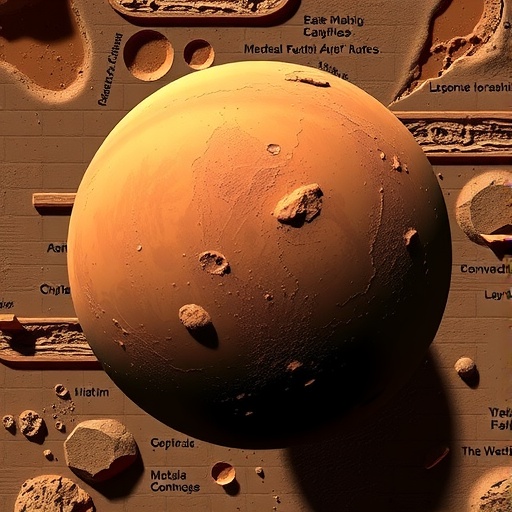Beneath the seemingly unchanging red surface of Mars lies a mantle that holds invaluable secrets about the planet’s distant past. New seismic data analyzed from NASA’s InSight mission has exposed a mantle unlike any seen on Earth—a mantle marked by profound heterogeneity and structural disorder. This fractured interior serves as a frozen record of Mars’ formative years, revealing clues about the planet’s geodynamic evolution and, by extension, the processes that shape rocky bodies in our solar system and beyond.
Mars, unlike Earth, is characterized by a stagnant lid tectonic regime, featuring a single rigid plate instead of the dynamic plate tectonics that continuously reshape Earth’s outer shell. This fundamental difference means that Mars’ mantle experiences far less convective mixing. Consequently, compositional variations and heterogeneities that might otherwise be erased over geologic time remain largely preserved. The InSight mission, designed to detect marsquakes and internal seismic activity, provided the high-fidelity data necessary to probe these subtle but telling features deep beneath the Martian crust.
The study, led by geophysicist Constantinos Charalambous and colleagues, focused on seismic wave travel times, particularly analyzing high-frequency P-wave measurements as they passed through the mantle layer. By examining eight carefully selected marsquakes, including those triggered by meteorite impacts, the team observed consistent delays in P-wave arrivals traversing the deeper mantle. These delays imply the presence of small-scale compositional variations, on the order of kilometers, that have survived since Mars’ earliest history, undisturbed by tectonic recycling.
This heterogeneity provides compelling evidence that Mars’ interior is a mosaic forged by violent, energetic processes. During the planet’s formative eons, massive planetary collisions—catastrophic impacts far more intense and frequent than current conditions allow—shattered and mixed the mantle, incorporating not only primordial material but also debris from extraterrestrial bodies and crustal fragments. The scale and distribution of this heterogeneity suggest that impact-driven fracturing was a dominant factor in setting the mantle’s current structure.
Following these immense collisions, the crystallization of global magma oceans likely further diversified the mantle’s chemical and thermal properties. Large volumes of molten rock solidifying at depth created stratified compositional layers, adding complexity to the mantle’s seismic structure. Instead of vigorous convection patterns found in Earth’s interior—which continuously remix and homogenize mantle material over time—Mars’ mantle convection diminished rapidly. As the planet cooled and its outer shell thickened, this cessation of mantle stirring effectively locked these ancient heterogeneities in place.
Understanding Mars’ mantle structure has implications far beyond the red planet itself. It provides a rare glimpse into the thermochemical evolution of terrestrial planets operating under stagnant lid conditions. Since stagnant lid tectonics is believed to be the norm for most rocky bodies in our solar system, insights gleaned from Mars illuminate the early geological and thermal histories of many other planets and moons whose interiors remain inaccessible for direct study.
Previously, Earth’s dynamic plate tectonics have erased or obscured much of its early mantle record, making it difficult to reconstruct its formative geologic processes. Mars, however, serves as an enduring archive of primordial planetary evolution. This difference underscores the importance of planetary seismology and the critical role of missions like InSight in expanding our understanding of planetary interiors beyond Earth.
The analysis also highlights the value of seismic waves as probes into planetary interiors. The subtle delays in seismic phases, such as P-waves, can reveal minute compositional differences and structural irregularities invisible to other remote sensing methods. With continued observation and analysis, seismology promises to refine models of Mars’ internal layering, mineralogy, and thermal gradients, deepening our knowledge of how planetary bodies differentiate and cool.
Moreover, the findings contribute to discussions on planetary habitability and geodynamic regimes. Because internal thermal evolution influences a planet’s magnetic field generation, volcanic outgassing, and surface environment stability, understanding the mantle’s structure informs models of Mars’ past and present habitability. The frozen record of mantle heterogeneity thus indirectly relates to the potential for life or prebiotic conditions on Mars and similar worlds.
The study’s implications extend to exoplanetary research, where planets are often inferred to have stagnant lid tectonics due to their size or composition. Mars, serving as a local analog, helps constrain the range of internal evolutions possible for rocky exoplanets. It also aids in refining criteria for habitability assessments when geological and geochemical data are scarce.
These new seismic insights represent a transformative leap in planetary science, broadening the horizons for comparative planetology. By combining seismic observations with geochemical, geophysical, and modeling approaches, scientists are piecing together the intricacies of planetary interiors and their evolutionary trajectories, deepening our understanding of the diverse processes that have shaped our solar system’s terrestrial planets.
Looking forward, further seismic data collection from Mars, potentially augmented by additional landers or orbiters, will be essential in confirming the preliminary models of mantle heterogeneity. Such advances will help resolve outstanding questions—such as the detailed scale, composition, and impact history of the mantle’s irregularities—and refine paradigms of planetary interior dynamics under stagnant lid regimes.
In essence, Mars’ quiet mantle is a time capsule holding the secrets of violent beginnings, a structural testament to the chaotic processes that not only shaped a world but also set the stage for the solar system as we know it. Unlocking its secrets brings us closer to answering fundamental questions about planetary formation, evolution, and the conditions that may foster life across the cosmos.
Subject of Research: Martian mantle structure and seismic heterogeneity
Article Title: Seismic evidence for a highly heterogeneous Martian mantle
News Publication Date: 28-Aug-2025
Web References: DOI link
References: Science Journal article, DOI 10.1126/science.adk4292
Keywords: Mars, Martian mantle, seismic heterogeneity, InSight mission, marsquakes, mantle convection, stagnant lid tectonics, planetary evolution, magma ocean crystallization, planetary impacts, geodynamics, thermochemical evolution




